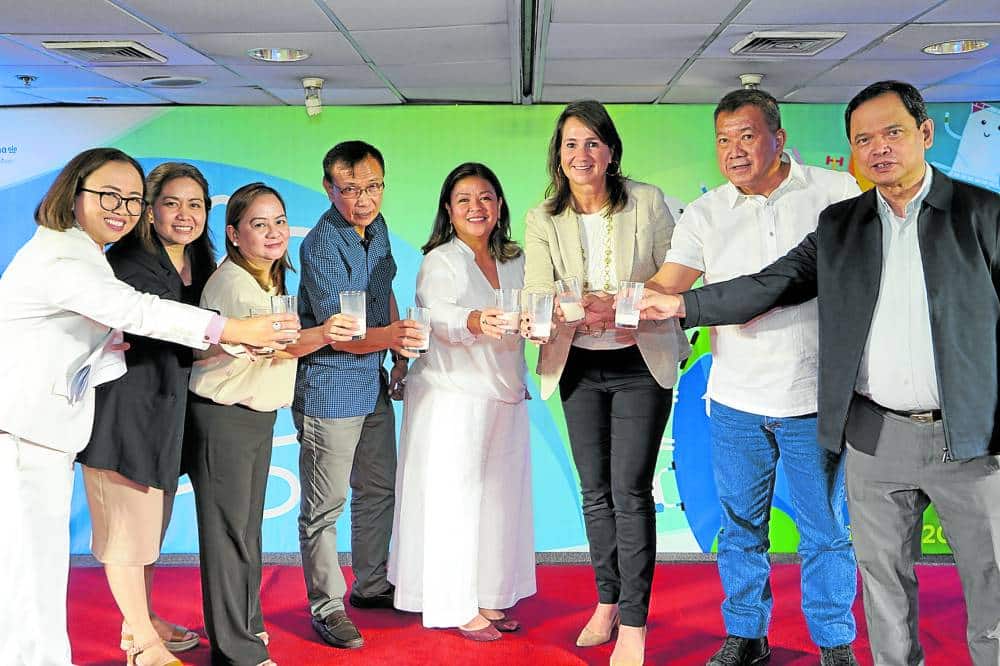Is there hope for PH dairy industry?

‘WHITE GOLD’ (From left) Cashmer Dirampaten, director of corporate and legal affairs of AMC; Liezel Atienza, professor at Institute of Human Nutrition and Food, UPLB; Magdalene Cariaga, registered nutritionist of Bureau of Learner Support, Services, Department of Education; Menandro Loresco, researcher at UPLB – Dairy Training and Research Institute; Estela Grace Estacio, AMC marketing director; Marielle Geraedts, Netherlands ambassador to the Philippines and Benjamin Albarece, agriculture assistant secretary and NDA officer in charge Gavino Alfredo Benitez toast with a glass of milk instead of wine. —CONTRIBUTED PHOTO
Climate change and rapid urbanization are hampering the growth of the domestic dairy industry.
With the prolonged dry season and lack of feed centers, local cattle, carabaos and goats are not producing enough milk for the growing population, making Filipinos even more reliant on imported dairy.
“It’s a recurring problem for the farmers looking for quality feed. So most of the feeds are coming from their pasture. But now the trend is to buy from external sources, mainly consisting of corn [and] spent grains. But the materials are getting very expensive,” explains Menandro Loresco, professor at Dairy Training and Research Institute of the University of the Philippines Los Baños (UPLB).
READ: PH designates land for dairy farming to increase milk sufficiency
Benjamin Albarece, agriculture assistant secretary for ruminant livestock, says that the country does not have good hay. Neither does it produce much its own silage, or animal feed made from green forage crops, unlike dairy powerhouses New Zealand and Australia.
Article continues after this advertisementBut Albarece says that the Philippines is working on creating its own silage. “Silage-making has become a new sunrise industry. Cooperatives are now producing silage mainly for the dairy industry,” he says in a forum hosted by Alaska Milk Corp. (AMC) in celebration of World Milk Day.
Article continues after this advertisementA drop in the bucket
The National Dairy Authority (NDA) says that as of 2023, the Philippines produced about 18,000 metric tons of milk, accounting for just 0.8 percent of the country’s annual milk consumption of 1.937 million metric tons. Local milk production last year saw a 5-percent decline.
With rapid urbanization, there’s a surge in demand to transform more agricultural lands into commercial, residential and industrial development. “In the ’70s, we had about 4 million hectares of grassland. Now we only have about less than a million or even lower than that,” Loresco adds.
READ: PH taps IP farms to boost dairy output
Nonetheless, increasing local milk production is part of “a strategy to promote food security, help solve malnutrition and increase the income of farmers in the dairy sector,” says lawyer Gavino Alfredo Benitez, NDA officer in charge and administrator.
The NDA is currently active in 67 provinces, managing 3,000 farmers with livestock and 250 cooperatives across the country. “Dairy farming is more than just an occupation. It is a way of life and a lifeline. Dairy farming supports thousands of families locally, providing a stable source of income and fostering rural development,” Benitez adds.
On the upside, Benitez notes that the local dairy herds are increasing albeit still much smaller compared with other dairy-producing countries. “Several large foreign companies have signified interest in investing in dairy in the country. They plan to put up large-scale integrated dairy farms within the millions of dollars and which require large plots of land,” he adds.

MILK FORUM (From left) Benjamin Albarece, agriculture assistant secretary; Liezel Atienza of Institute of Human Nutrition and Food, University of the Philippines Los Baños (UPLB); Menandro Loresco, professor at UPLB – Dairy Training and Research Institute; Magdalene Cariaga, registered nutritionist, Department of Education; Estela Grace Estacio, marketing director, Alaska Milk; and emcee Jing Castaneda tackle the challenges faced by the Philippine dairy industry. —VANESSA B. HIDALGO
What to do
Loresco says that sustainable dairy farming can ensure the uninterrupted supply of dairy products in the local market. He adds that the country needs a billion cows in order to be self-sufficient. Other than high-feed production, the industry must also consider factors that directly affect soil fertility, he explains.
He also emphasizes the need to build more storage facilities, where feeds can be preserved especially during the dry season. “You might have a lot of good animals, but you don’t have [enough] feed to supply the animals,” he adds.
“We are now focusing on how to mitigate greenhouse gas production. So it’s another thing to reduce global warming, which is affecting not only the farming community but all of us,” he says.
Benitez adds that the NDA is building more regional feed centers and water pumping stations. Although just “temporary measures,” these are seen to help increase productivity.
Albarece notes that collaborations with various sectors will help accelerate the development of this industry.
Private firms such as AMC have been helping by training dairy farmers. In addition, AMC’s mother company, Netherlands-based Friesland Campina, intends to buy milk from the Philippines, in an effort to boost the global competitiveness of local dairy producers.
Liezel Atienza, professor at the Institute of Human Nutrition and Food of UPLB, notes that most Filipinos are lactose-intolerant. She says that this is due to the absence of milk and other dairy products in their daily consumption.
“We are not really milk drinkers in the Philippines. The prevalence of calcium deficiency is around 95 percent. So it’s like nine out of 10 of Filipinos are calcium-deficient,” she adds.
Undernutrition remains a serious problem among Filipino children aged 5 to 10, with about 2.7 million children being too short for their age, potentially affecting their cognitive and physical development.
AMC wants to promote milk consumption as part of a balanced and healthy diet. Tarang Gupta, managing director of AMC, describes milk as “white gold”—in its purest form a whole source of nutrition. “Dairy creates an impact from end to end in any community, whether you are in the farms raising cows or at home preparing a nutritious meal,” Gupta adds.
“By educating consumers about the comprehensive nutritional benefits of milk and ensuring access to high-quality yet affordable dairy products, we can contribute significantly to fostering healthier communities,” says Estela Estacio, marketing director of AMC.